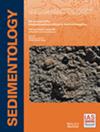Assessing the origin of pisoids within a travertine system in the border of Puna Plateau, Argentina
IF 2.6
2区 地球科学
Q1 GEOLOGY
引用次数: 5
Abstract
The origin of pisoids in a diversity of environments has been recently discussed. While traditionally considered physico‐chemical sedimentary products developed in turbulent environments, or even grown in situ, new results show that microbes may influence their development. In the Terma Los Hornos travertine system, two types of actively forming pisoids were recognized: (i) laminated pisoids with a concentrically laminated crust surrounding a nucleus; and (ii) dendriform radial pisoids with no distinct nucleus. Laminated pisoids form in turbulent pools at the base of waterfalls, while dendritic pisoids develop within small depressions between terracettes, and they can occur superposed as a result of episodic transport and recycling within the travertine system (for example, dendritic textures as nucleus of laminated pisoids). The laminated pisoids are characterized by laterally constant laminae thickness with high inheritance and low amounts of randomly distributed organic matter and microbial remains, suggesting a predominantly abiogenic origin. In contrast, the dendritic pisoids exhibit an intimate relationship with diatoms and filamentous bacteria suggesting a stronger biotic influence in their formation. Thus, both abiogenic and biogenic carbonate structures can coexist in the same hydrothermal system. Pisoids found in the stratigraphic record of Terma Los Hornos allowed to test the preservation potential of the primary signals and reconstructing early diagenetic overprints.在阿根廷普纳高原边界的石灰华系统中评估类蛇的起源
最近,人们讨论了不同环境下蛇尾虫的起源。虽然传统上认为物理化学沉积产物是在湍流环境中形成的,甚至是在原位生长的,但新的研究结果表明,微生物可能会影响它们的发育。在Terma Los Hornos钙华体系中,可识别出两种活跃形成的蛇状体类型:(i)层状蛇状体,其同心层状地壳围绕着一个核;(2)树状放射状核状体,无明显核。层状的蝎状体形成于瀑布底部的湍流池中,而树突状的蝎状体则形成于梯田之间的小洼地中,它们可以在钙华系统内的偶发运输和再循环中叠加出现(例如,树突结构作为层状的蝎状体的核)。层状类松体具有横向层状厚度恒定、遗传程度高、随机分布的有机质和微生物残留量少的特点,以非生物成因为主。相比之下,树突类鱼与硅藻和丝状细菌有着密切的关系,这表明它们的形成受到了更强的生物影响。因此,在同一热液系统中,非生物成因和生物成因的碳酸盐岩结构可以共存。在Terma Los Hornos地层记录中发现的鱼状体可以测试原始信号的保存潜力并重建早期成岩叠层。
本文章由计算机程序翻译,如有差异,请以英文原文为准。
求助全文
约1分钟内获得全文
求助全文
来源期刊

Sedimentology
地学-地质学
CiteScore
8.20
自引率
11.40%
发文量
94
审稿时长
6-12 weeks
期刊介绍:
The international leader in its field, Sedimentology publishes ground-breaking research from across the spectrum of sedimentology, sedimentary geology and sedimentary geochemistry.
Areas covered include: experimental and theoretical grain transport; sediment fluxes; modern and ancient sedimentary environments; sequence stratigraphy sediment-organism interaction; palaeosoils; diagenesis; stable isotope geochemistry; environmental sedimentology
 求助内容:
求助内容: 应助结果提醒方式:
应助结果提醒方式:


